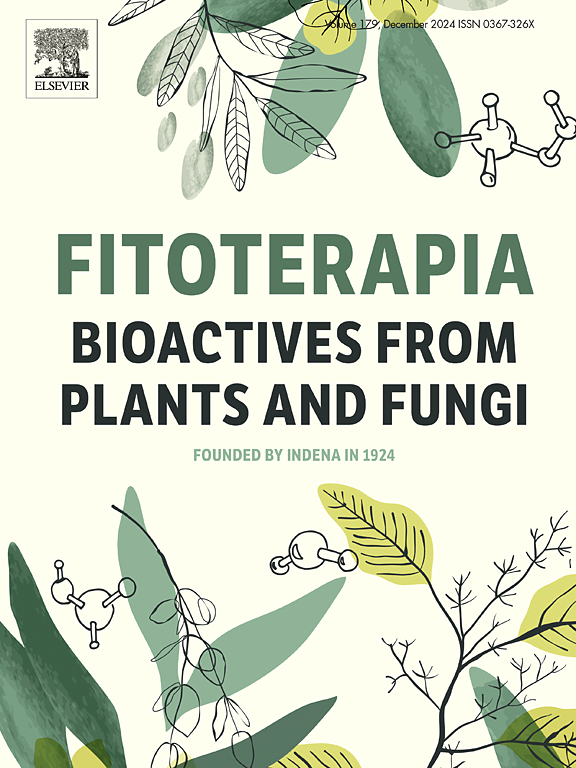Pomegranate (Punica granatum L.): A narrative review of its protective role against nephrotoxicity
IF 2.6
3区 医学
Q3 CHEMISTRY, MEDICINAL
引用次数: 0
Abstract
Background
Pomegranate (Punica granatum L.) has been traditionally used in various cultures for its health benefits, particularly in promoting kidney health. Its rich composition of bioactive compounds, including polyphenols and flavonoids, has drawn attention for their potential protective effects against nephrotoxicity, a condition characterized by kidney damage due to various toxic agents.
Aim of the study
This review aims to evaluate the efficacy of pomegranate and its active constituents in mitigating nephrotoxicity and promoting kidney health.
Methods
A literature review was conducted from 2010 to 2025, encompassing relevant in vitro and in vivo studies sourced from databases such as Scopus, Google Scholar, Web of Science, and PubMed. The focus was on the effects of pomegranate on nephrotoxicity and its underlying mechanisms.
Results
The nephroprotective effects of pomegranate are attributed to its bioactive compounds, including ellagic acid, gallic acid, and punicalagin, which exhibit robust antioxidant properties and reduce inflammation, apoptosis, and fibrosis. These compounds suppress the TGF-β1/Smad pathway while enhancing protective regulators (SIRT1, SIRT6, TUG1, and Nrf2), contributing to antioxidant defense and cellular homeostasis. Furthermore, pomegranate mitigates nephrotoxicity by decreasing markers like MCP-1, NF-κB, LDH, HIF-1α, KIM-1, and NGAL, and it modulates renal transport proteins (OAT1 and OAT3). By preserving glomerular filtration rate, alleviating tubular damage, and promoting renal repair mechanisms, pomegranate demonstrates its protective actions against nephrotoxicity.
Conclusion
Pomegranate shows multifaceted nephroprotective properties through modulation of oxidative stress, inflammation, fibrosis, and apoptosis-related signaling pathways. However, further research is essential to confirm these findings, explore clinical applications, and evaluate safety profiles and potential interactions with other medications.

石榴(Punica granatum L.):对其抗肾毒性保护作用的综述
石榴(Punica granatum L.)传统上在各种文化中被用于其健康益处,特别是促进肾脏健康。其丰富的生物活性成分,包括多酚和类黄酮,因其对肾毒性的潜在保护作用而受到关注,肾毒性是一种以各种有毒物质引起的肾脏损害为特征的疾病。研究目的本文旨在评价石榴及其有效成分在减轻肾毒性和促进肾脏健康方面的作用。方法回顾2010年至2025年的文献,包括Scopus、b谷歌Scholar、Web of Science和PubMed等数据库中相关的体外和体内研究。重点研究了石榴对肾毒性的影响及其潜在机制。结果石榴的肾保护作用是由于其生物活性成分,包括鞣花酸、没食子酸和石榴苷,具有强大的抗氧化性能,减少炎症、细胞凋亡和纤维化。这些化合物抑制TGF-β1/Smad通路,同时增强保护性调节因子(SIRT1、SIRT6、TUG1和Nrf2),有助于抗氧化防御和细胞稳态。此外,石榴通过降低MCP-1、NF-κB、LDH、HIF-1α、KIM-1和NGAL等标志物,以及调节肾脏转运蛋白(OAT1和OAT3)来减轻肾毒性。通过保持肾小球滤过率,减轻肾小管损伤,促进肾修复机制,石榴显示了其对肾毒性的保护作用。结论石榴通过调节氧化应激、炎症、纤维化和细胞凋亡相关信号通路,具有多方面的肾保护作用。然而,需要进一步的研究来证实这些发现,探索临床应用,评估安全性和与其他药物的潜在相互作用。
本文章由计算机程序翻译,如有差异,请以英文原文为准。
求助全文
约1分钟内获得全文
求助全文
来源期刊

Fitoterapia
医学-药学
CiteScore
5.80
自引率
2.90%
发文量
198
审稿时长
1.5 months
期刊介绍:
Fitoterapia is a Journal dedicated to medicinal plants and to bioactive natural products of plant origin. It publishes original contributions in seven major areas:
1. Characterization of active ingredients of medicinal plants
2. Development of standardization method for bioactive plant extracts and natural products
3. Identification of bioactivity in plant extracts
4. Identification of targets and mechanism of activity of plant extracts
5. Production and genomic characterization of medicinal plants biomass
6. Chemistry and biochemistry of bioactive natural products of plant origin
7. Critical reviews of the historical, clinical and legal status of medicinal plants, and accounts on topical issues.
 求助内容:
求助内容: 应助结果提醒方式:
应助结果提醒方式:


